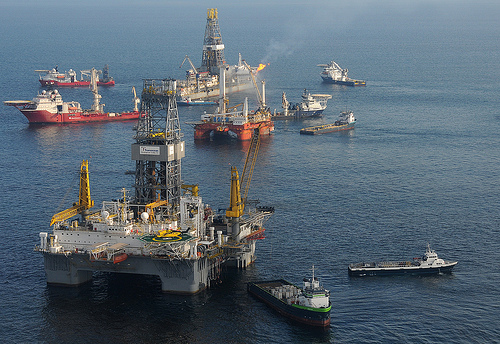Was the Obama administration “arbitrary and capricious” in imposing a six-month moratorium on deepwater oil drilling? U.S. District Judge Martin Feldman thought so. His June 22 order reversed the moratorium, citing the “immeasurable harm” to “the local economy, the Gulf region, and the critical present-day aspect of the availability of domestic energy in this country.” By immeasurable harm to the Gulf region, he meant the loss of oil industry jobs, not the loss of oil-free water and beaches.
How could anyone be opposed to a time-out to figure out what went wrong in the Gulf of Mexico? Others close to the industry can see the risk: According to Moody’s Investor Service, insurance rates for offshore drilling rigs have increased by 15 to 25 percent for shallow water rigs, and up to 50 percent for deepwater rigs, since the Deepwater Horizon disaster.
It’s difficult to take low-probability, high-risk events seriously — especially when there are short-term rewards for closing your eyes to them, until they happen. This is an immense stumbling block in the climate policy debate, which often involves extreme risks that haven’t happened yet. But the current oil disaster involves risks that have happened — and are still declared less important than making money as usual.
Consider one worst-case scenario: An offshore well has a blowout, causing an explosion that destroys the drilling rig, which capsizes and sinks. The blowout preventer, designed as the final fail-safe protection for emergencies such as this, is unable to stop the oil gushing out of the well. A “junk shot,” attempting to plug the well with debris, also fails.
When this happened in 1979, at the Ixtoc well off the coast of Mexico, the oil industry might have been surprised. It should have been a good bit less surprising when it happened again in 2010. Interestingly, the first relief well drilled at Ixtoc also failed; that spill went on for more than nine months, pouring more than 3 billion barrels of oil into the Caribbean.
Running out of low-risk resources
As I’ve written before, the world is not running out of oil — but it is running out of low-risk, conventional energy resources. This means that the price of energy has everything to do with the way that we understand and manage risk. If we ignore or deny the risk, and assume that the government (i.e., the taxpaying public) will pay for any catastrophic losses, then industry can keep the price relatively low, at least in the times between disasters. Thus Judge Feldman mocked the idea that problems with one oil well could imply anything about safety at another well: “If some drilling equipment parts are flawed, is it rational to say all are?”
BP, in fact, must have assumed that an Ixtoc-style failure was impossible today. Its 2009 spill response plan for the Gulf of Mexico looks like hastily assembled, unedited boilerplate: Among other obvious errors, it suggests contacting an expert who died in 2005, and mentions impacts on walruses, sea lions, otters, and seals, none of which are found in or near the Gulf region. Even since the Deepwater Horizon blowout, BP has continued drilling another well — this time in walrus country, in the Beaufort Sea, off the north coast of Alaska — using an untested new technique which, according to some experts, could increase the risk of gas explosions. BP executives must be aware that another uncontrollable blowout would be the end of the company, so they must still be certain that accidents never happen.
Incredibly enough, according to an in-depth New York Times report, the risks of failure of blowout preventers were well-known to the industry, and to the feckless Minerals Management Service which was, in theory, regulating oil drilling. In 11 deepwater blowouts since 1980, the blowout preventer worked only six times; that’s a 45-percent failure rate. Yet even as the industry began to build new drilling rigs with better blowout preventers, they continued using older ones such as the Deepwater Horizon. The reason was that it would be so expensive to take a drilling rig out of service for major repairs, costing an estimated $700 per minute of lost production.
At that rate, the cost of the accident to BP so far, including the $20 billion it has agreed to pay for damages to the Gulf region and perhaps another $1 billion of its own costs, looks like 30 million minutes of lost production — or 57 years’ worth. If they could have installed a better blowout preventer in less than 57 years of repair work on the Deepwater Horizon, they would have come out ahead. On the other hand, if catastrophic accidents are as unlikely as walruses showing up in the Gulf of Mexico, why waste money on needless safety precautions?
Energy policy with our eyes open
What would happen if we admitted the level of risk that is involved? During the deepwater drilling moratorium, we would find it was worthwhile to insist on state-of-the-art blowout preventers and other safety devices on all drilling rigs, new or old. Repairs at a cost of only $700 a minute are a bargain, considering the alternative. Perhaps some excessively deep or otherwise risky locations (in the path of hurricanes, for instance) would be declared off limits altogether.
This would lead to less oil production, and higher prices. Indeed, even the increased insurance premiums may be enough to shut down some marginal drilling projects; business analysts have complained that this will be particularly hard on smaller companies. That sounds like good news: Companies too small to do the job safely have no business being involved in something as risky as offshore drilling.
Would the costs of safe oil drilling be high enough to get Americans to buy sensibly small, fuel-efficient cars, and to support public transportation? We’d all be better off in more than one way, if that were the result.
The era of cheap, safe oil is over. We used it up, not wisely, but too well. It’s time to invent an energy system that protects us, and the walruses, and the global climate.



